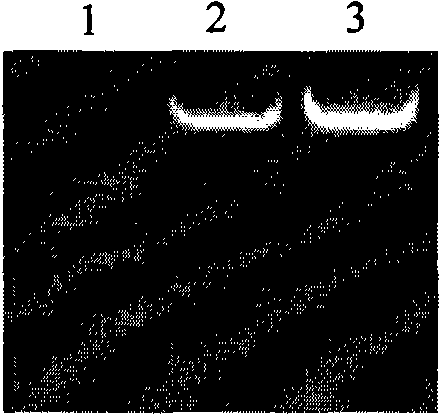Specific expression promoter for plant embryo and application thereof
A specific and promoter technology, applied in the fields of application, plant products, botanical equipment and methods, etc., can solve the problems of lack of embryo-specific molecular or cell markers, technical difficulties in cloning seed embryo-specific genes, etc.
- Summary
- Abstract
- Description
- Claims
- Application Information
AI Technical Summary
Problems solved by technology
Method used
Image
Examples
Embodiment 1
[0037] Embodiment 1, the acquisition of plant embryo-specific expression promoter (16 kDa oleosin promoter)
[0038] According to the cDNA sequence of the rice 16 kDa oleosin gene (GenBank number L76464), the upstream sequence of the 16 kDa oleosin gene was searched from GenBank, and primers were designed to amplify the 16 kDa oleosin promoter. To facilitate vector construction, two restriction sites (underlined) were sequentially added to each pair of primers. The forward primer for the 16kDa oleosin promoter is F1: 5'-ACC AAGCTT CGCTGATGTGGTATCATAG-3' (Hind III) and reverse primer R1: 5'AA GTC GAC GGGGATCGAGCACACCTGCAG-3' (Sal I).
[0039] The CTAB method was used to extract a small amount of genome from the leaves of rice (wild type rice Taichung No. 65, which was bred in Taiwan Province of my country in 1936; Qu Leqing et al., Acta Botany, 2001, 43: 1167-1171; preserved by the Institute of Botany, Chinese Academy of Sciences) Using DNA as a template and using F1 and R...
Embodiment 2
[0040] Embodiment 2, plant embryo-specific expression promoter (16 kDa oleosin promoter) expression vector construction and genetic transformation
[0041] 1. Construction of plant expression vector with 16KDa oleosin promoter fused to GUS gene
[0042] pGPTV-35S-HPT was constructed with reference to the method described in the literature (Qu and Takaiwa, Plant Biotech J 2004, 2: 113-125), and was preserved by the Institute of Botany, Chinese Academy of Sciences. The pT7-oleP plasmid and the binary expression vector pGPTV-35S-HPT were digested with Hind III and Sal I. Recover an enzyme-digested fragment containing 1438bp of 16 kDa oleosin promoter, and connect this fragment between the Hind III and Sal I enzyme recognition sites of pGPTV-35S-HPT. On the basis of PCR identification, the obtained recombinant plasmid was identified by double enzyme digestion with Hind III and Sal I, and a 1.4 kb fragment of 16 kDa oleosin promoter was obtained. Recombinant plasmid indicated by ...
Embodiment 3
[0048] Embodiment 3, Southern hybridization detection of transgenic rice plants
[0049] Using CTAB method to extract positive T cells identified by PCR 0 For the genomic DNA of rice transgenic plant leaves, about 40 μg of DNA was added to 50 units of EcoR I to fully digest, and after separation by 0.8% agarose gel electrophoresis, the DNA was transferred to a positively charged nylon membrane with 0.4N NaOH ( purchased from Amersham pharmacia). The transferred membrane was pre-hybridized in 0.5M sodium phosphate buffer containing 7% (W / V) SDS at 65°C for 5 hours, and the probe was labeled with [α-32P]dCTP random primer method (purchased from China Furui Co., Ltd. ). The hybridization probe used is a 441bp DNA fragment located inside GUS (the sequence is the 1344-1784th nucleotide sequence from GENBANK No. S69414.1, with the pGPTV-35S-HPT plasmid as a template, 5'-CTGCGACGCTCACACCGATACC- 3' and 5'-TCACCGAAGTTCATGCCAGTCCAG-3' are primers for PCR amplification products) as pr...
PUM
 Login to View More
Login to View More Abstract
Description
Claims
Application Information
 Login to View More
Login to View More - R&D
- Intellectual Property
- Life Sciences
- Materials
- Tech Scout
- Unparalleled Data Quality
- Higher Quality Content
- 60% Fewer Hallucinations
Browse by: Latest US Patents, China's latest patents, Technical Efficacy Thesaurus, Application Domain, Technology Topic, Popular Technical Reports.
© 2025 PatSnap. All rights reserved.Legal|Privacy policy|Modern Slavery Act Transparency Statement|Sitemap|About US| Contact US: help@patsnap.com



